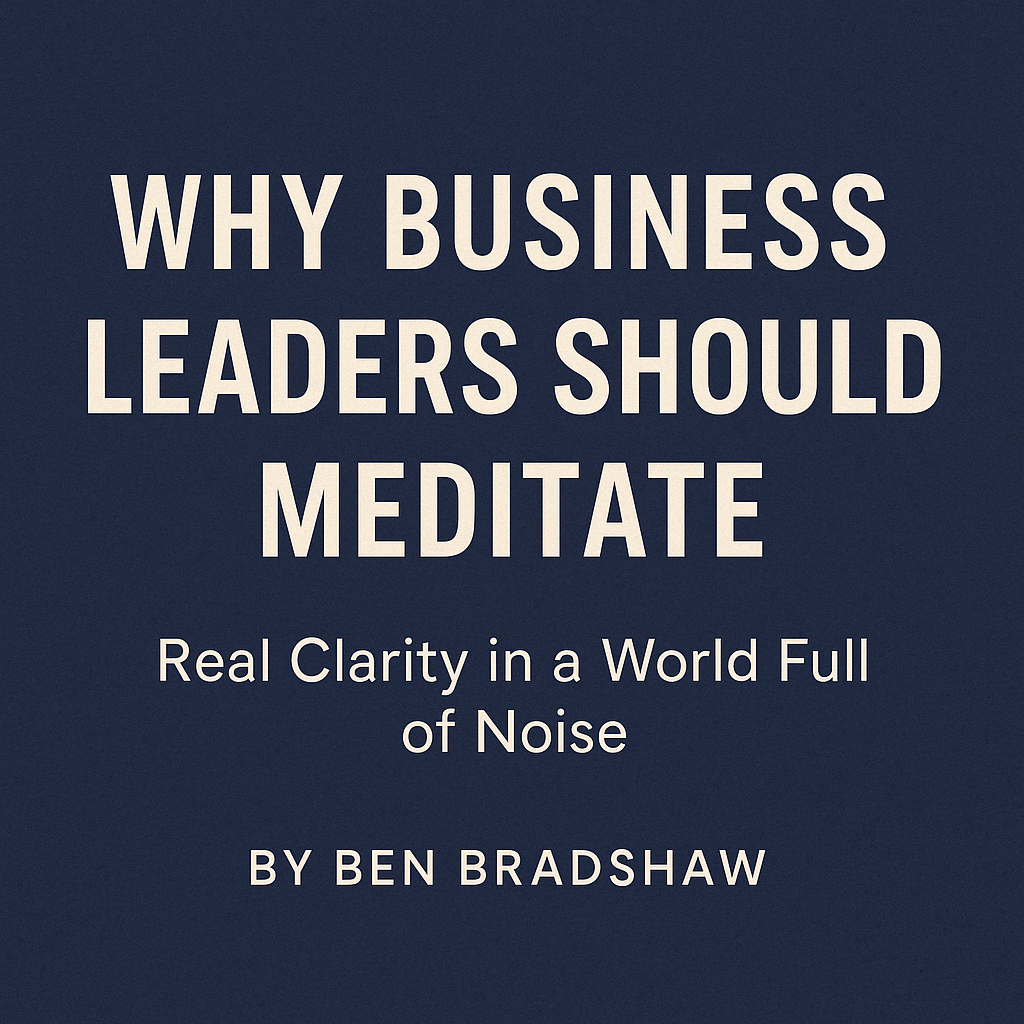By Ben Bradshaw
I didn’t discover meditation because I was looking for peace.
I discovered it because success stopped feeling like success.
On paper, I had everything: multiple businesses, press features, awards, momentum. But inside, I was spinning. I couldn’t tell if the next big decision was intuitive or reactive. My nervous system was constantly locked in go mode. My team was feeling it. So was I.
That’s when I started Transcendental Meditation, not to escape, but to reconnect with the signal underneath it all.
What No One Tells You About Leading From Static
Most leaders don’t realise they’re operating from a scrambled frequency.
They’re sharp, but reactive. Focused, but fragile. They’re running on cortisol, caffeine, and adrenaline. That’s not sustainable, and it’s not true clarity.
Meditation gave me my signal back.
The first time I dropped into stillness using the Vedic mantra technique, it wasn’t just quiet. It was coherent. It felt like my thoughts were recalibrating. And from that stillness, the right decisions didn’t just appear, they felt inevitable.
This wasn’t about becoming spiritual. It was about becoming strategic, without losing myself.
TM: Not Woo, Just Proven
Transcendental Meditation (TM) is one of the most well-researched meditation techniques on the planet.
It’s a simple, effortless method that involves silently repeating a mantra for 20 minutes twice a day. Unlike mindfulness or breathwork, TM is designed to allow the mind to transcend thought, to drop into a deeper resting state where the nervous system recalibrates and the brain reorganises.
And the science is crystal clear:
- A study at American University found that TM increases frontal brainwave coherence, which enhances focus, intuition, and emotional regulation Travis et al., 2009.
- TM has been shown to reduce cortisol levels, lower blood pressure, and restore autonomic balance, key for reversing chronic stress Orme-Johnson & Barnes, 2014.
- In a major 5-year study, participants practising TM had a 48% lower rate of heart attack, stroke, and death compared to controls Schneider et al., 2012, Circulation.
- TM has even been used to treat PTSD, anxiety, and insomnia in veterans with significant results in under a month Nidich et al., 2018, Military Medicine.
This isn’t theory. This is a tool with decades of data behind it, and one I’ve used every day since.
What TM Did for Me as a Business Owner
Tangible results from two 20-minute sessions a day:
- I started making sharper decisions, with less mental drain
- My meetings became clearer, shorter, more effective
- I stopped second-guessing my gut
- I handled pressure without absorbing it
- Creativity returned, not forced, but flowing
- I showed up calmer, more present, more trusted
And perhaps most importantly, I reconnected with the part of me that wasn’t just running a business, but broadcasting a field.
Because that’s what leadership really is.
You’re not just giving instructions. You’re setting the frequency the room tunes to.
Stillness Is Strategy
The idea that leaders should meditate isn’t new.
What’s new is that it’s no longer optional.
The business world is full of complexity, uncertainty, and noise. Leaders who pause, listen, and tune into coherence will navigate chaos with presence.
Leaders who don’t will get swallowed by it.
TM taught me how to be still without stagnating.
How to let the answers arise before my mind starts solving.
How to lead from resonance instead of reaction.
How to Start (The Zero-Fluff Guide)
No incense required. No monk robes. Just a chair and a mantra.
Here’s a simple, effective approach based on Vedic principles:
Step 1: Sit
Twice a day, sit somewhere quiet. Close your eyes. Take a few gentle breaths.
Step 2: Use a Mantra
Silently repeat a mantra, one given by a qualified TM teacher, or a soft sound like “so-hum” if you’re just starting. Let it come and go. Don’t force.
Step 3: Allow Thoughts to Rise and Fall
You’re not trying to stop thoughts. You’re observing, not attaching. If you drift, come back to the mantra. Let the mind settle.
Step 4: After 20 Minutes, Rest
Open your eyes slowly. Sit for a minute before returning to your day. Let the integration land.
If 20 minutes feels like too much, start with 10. Stillness compounds. Clarity builds.
Final Thought: Meditation Is the Leadership Edge No One Talks About
Some people lift weights.
I meditate.
It’s my daily tune-up for clarity, presence, and power, not power over others, but over my own field.
And that’s what every business leader truly needs.
Not just better systems. Not just sharper strategy.
A stronger signal.
Meditation didn’t make me soft. It made me precise.
And that changed everything.

